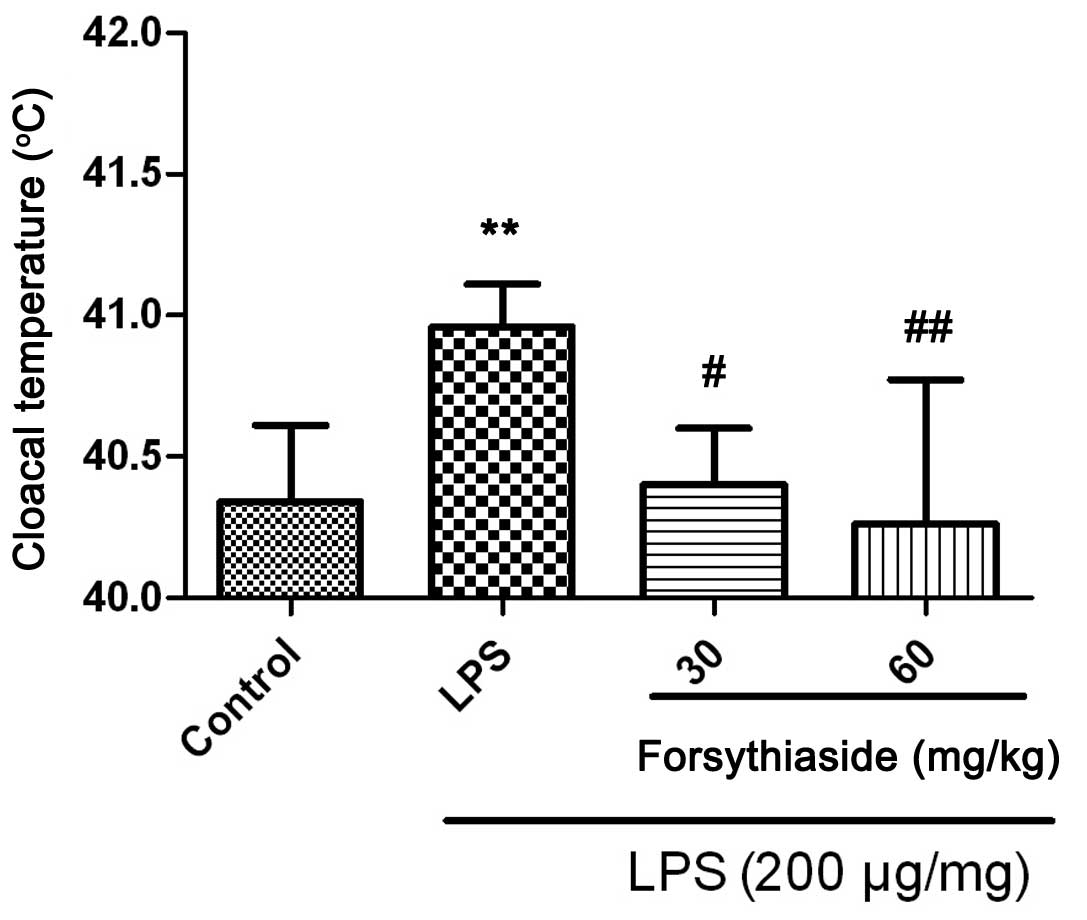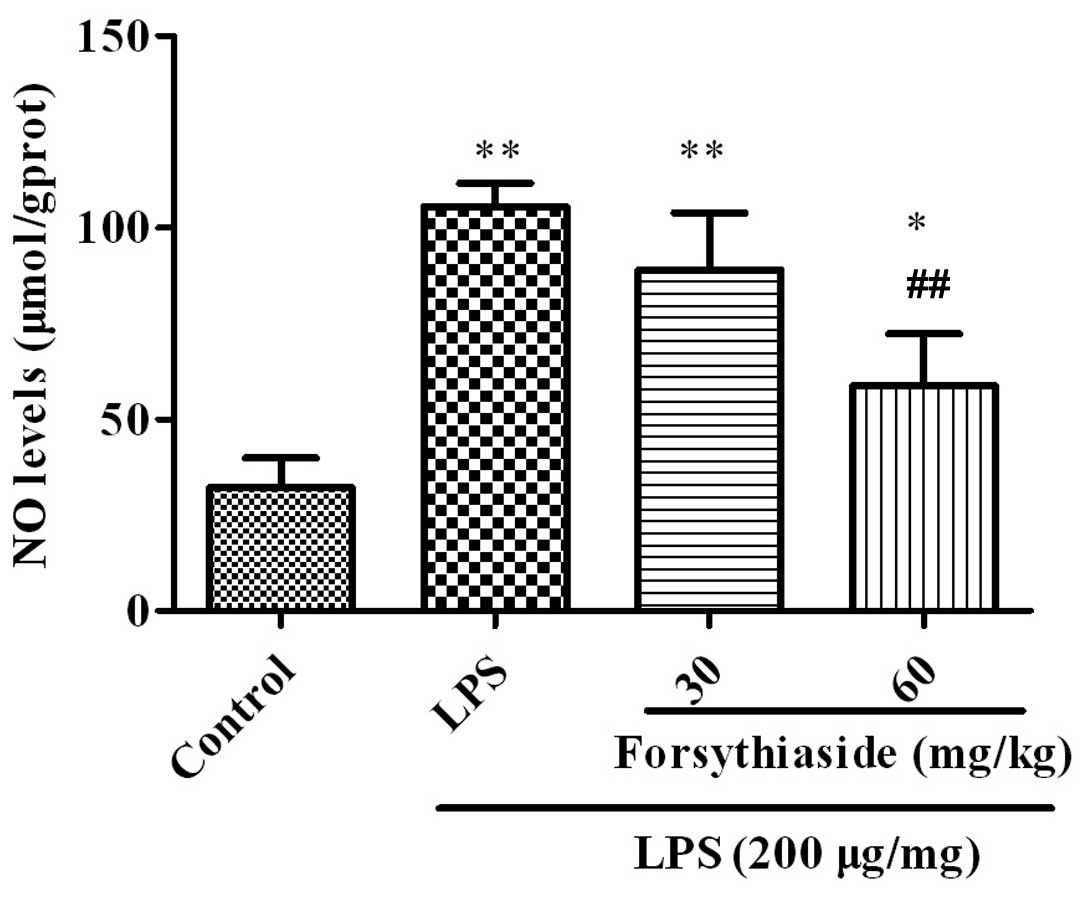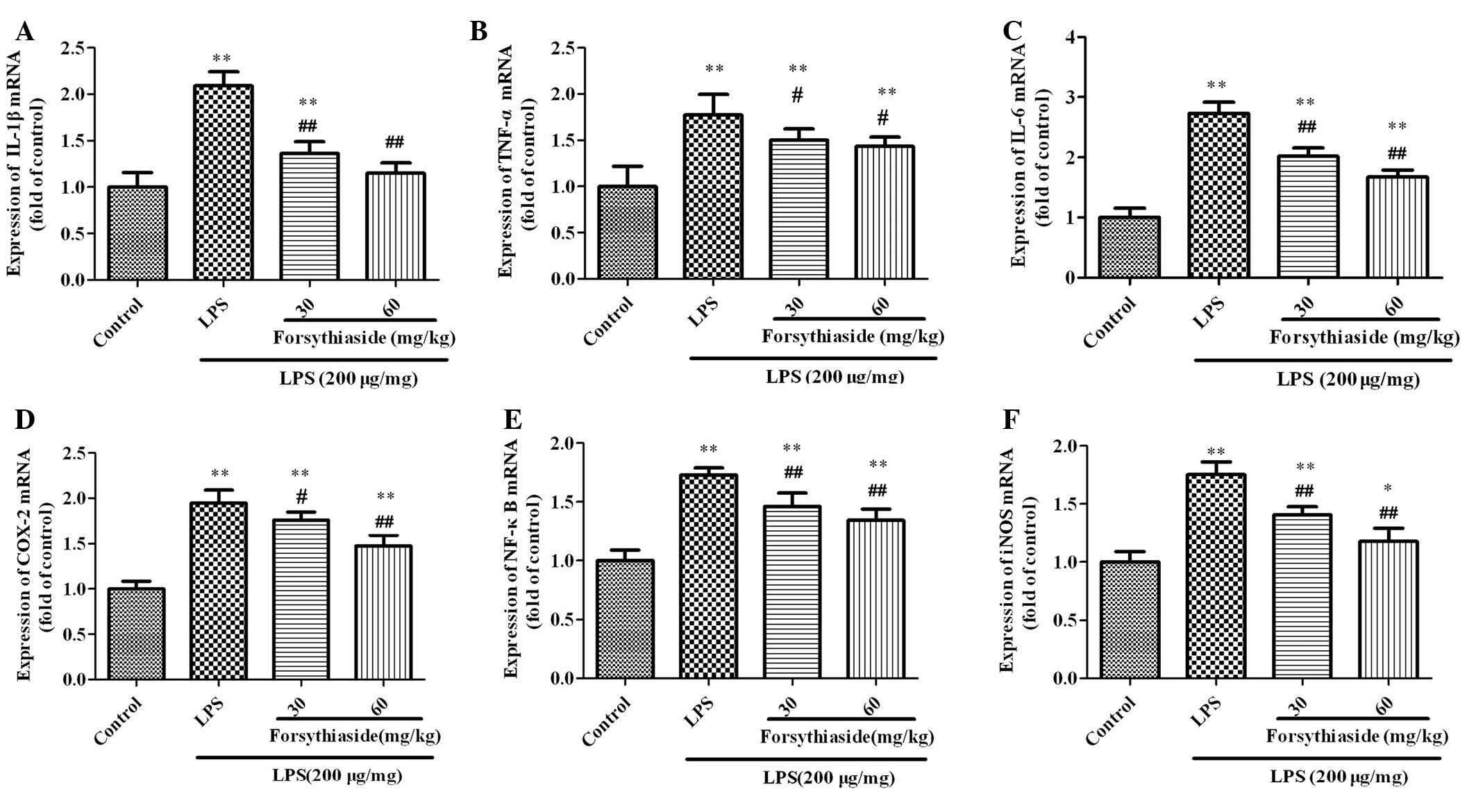|
1
|
Shao DZ and Lin M: Platonin inhibits
LPS-induced NF-kappaB by preventing activation of Akt and IKKbeta
in human PBMC. Inflamm Res. 57:601–606. 2008. View Article : Google Scholar : PubMed/NCBI
|
|
2
|
Shen YB, Piao XS, Kim SW, et al: The
effects of berberine on the magnitude of the acute inflammatory
response induced by Escherichia coli lipopolysaccharide in
broiler chickens. Poult Sci. 89:13–19. 2010. View Article : Google Scholar : PubMed/NCBI
|
|
3
|
Bhatia M and Moochhala S: Role of
inflammatory mediators in the pathophysiology of acute respiratory
distress syndrome. J Pathol. 202:145–56. 2004. View Article : Google Scholar : PubMed/NCBI
|
|
4
|
Chen X, Yang X, Liu T, Guan M, et al:
Kaempferol regulates MAPKs and NF-κB signaling pathways to
attenuate LPS-induced acute lung injury in mice. Int
Immunopharmacol. 14:209–216. 2012.PubMed/NCBI
|
|
5
|
Mallard C: Innate immune regulation by
toll-like receptors in the brain. ISRN Neurol. 2012:7019502012.
View Article : Google Scholar : PubMed/NCBI
|
|
6
|
Oeckinghaus A, Hayden MS and Ghosh S:
Crosstalk in NF-κB signaling pathways. Nat Immunol. 12:695–708.
2011.
|
|
7
|
Li HB and Chen F: Preparative isolation
and purification of phillyrin from the medicinal plant Forsythia
suspensa by high-speed counter-current chromatography. J
Chromatogr A. 1083:102–105. 2005. View Article : Google Scholar : PubMed/NCBI
|
|
8
|
Lee JY, Cho BJ, Park TW, et al:
Dibenzylbutyrolactone lignans from Forsythia koreana fruits
attenuate lipopolysaccharide-induced inducible nitric oxide
synthetase and cyclooxygenase-2 expressions through activation of
nuclear factor-κb and mitogen-activated protein kinase in RAW264.7
cells. Biol Pharm Bull. 33:1847–1853. 2010.
|
|
9
|
Sheng Z, Li JC and Li YH: Optimization of
forsythoside extraction from Forsythia suspensa by
Box-Behnken design. Afr J Biotechnol. 10:11728–11737. 2011.
|
|
10
|
Kinoshita K, Kawai T, Imaizumi T, et al:
Anti-emetic principles of Inula linariaefolia flowers and
Forsythia suspensa fruits. Phytomedicine. 3:51–58. 1996.
|
|
11
|
Wang L, Piao XL, Kim SW, et al: Effects of
Forsythia suspensa extract on growth performance, nutrient
digestibility, and antioxidant activities in broiler chickens under
high ambient temperature. Poult Sci. 87:1287–1294. 2008.
|
|
12
|
Li YH, Li MY, Cui L, et al: The effects of
ethanol extracts from Forsythia suspensa against
antibiotic-resistant Streptococcus suis isolates in vivo and
in vitro. In: Int Conf Bioinform Biomed Eng: 5th International
Conference; pp. 1–5. 2011
|
|
13
|
Qu H, Zhang Y, Wang Y, et al: Antioxidant
and antibacterial activity of two compounds (forsythiaside and
forsythin) isolated from Forsythia suspensa. J Pharm
Pharmacol. 60:261–266. 2008. View Article : Google Scholar : PubMed/NCBI
|
|
14
|
Li J and Zhang FX: Studies on the
antibiotic and antioxidant activities of weeping forsythia applied
in Chinese-style sausage. Chin Agric Sci Bull. 4:112–115. 2006.(In
Chinese).
|
|
15
|
Liu WB, Li DP, Zhang GL, et al: Study
progress of the pharmacological activity of Forsythoside A.
Zhongguo Xu Mu Shou Yi. 7:236–238. 2011.(In Chinese).
|
|
16
|
Jiang WL, Fu FH, Xu BM, et al:
Cardioprotection with forsythoside B in rat myocardial
ischemia-reperfusion injury: relation to inflammation response.
Phytomedicine. 17:635–639. 2010. View Article : Google Scholar : PubMed/NCBI
|
|
17
|
Sahpaz S, Garbacki N, Tits M and Bailleil
F: Isolation and pharmacological activity of phenylpropanoid esters
from Marrubium vulgare. J Ethnopharmacol. 79:389–3892. 2002.
View Article : Google Scholar : PubMed/NCBI
|
|
18
|
Martin-Nizard F, Sahpaz S, Furman C, et
al: Natural phenylpropanoids protect endothelial cells against
oxidized LDL-induced cytotoxicity. Planta Med. 69:207–211. 2003.
View Article : Google Scholar
|
|
19
|
Martin-Nizard F, Sahpaz S, Kandoussi A, et
al: Natural phenylpropanoids inhibit lipoprotein-induced
endothelin-1 secretion by endothelial cells. J Pharm Pharmacol.
56:1607–1611. 2004. View Article : Google Scholar
|
|
20
|
Koutsos EA, García López JC and Klasing
KC: Carotenoids from in ovo or dietary sources blunt systemic
indices of the inflammatory response in growing chicks (Gallus
gallus domesticus). J Nutr. 136:1027–1231. 2006.PubMed/NCBI
|
|
21
|
Xie H, Rath NC, Huff GR, et al: Effects of
Salmonella typhimurium lipopolysaccharide on broiler
chickens. Poult Sci. 79:33–40. 2000.
|
|
22
|
Meriwether LS, Humphrey BD, Peterson DG,
et al: Lutein exposure, in ovo or in the diet, reduces parameters
of inflammation in the liver and spleen laying-type chicks
(Gallus gallus domesticus). J Anim Physiol Anim Nutr (Berl).
94:e115–e122. 2010. View Article : Google Scholar : PubMed/NCBI
|
|
23
|
Shanmugasundaram R and Selvaraj RK: Lutein
supplementation alters inflammatory cytokine production and
antioxidant status in F-line turkeys. Poult Sci. 90:971–976. 2011.
View Article : Google Scholar : PubMed/NCBI
|
|
24
|
MacKay RJ and Lester GD: Induction of the
acute-phase cytokine, hepatocyte-stimulating factor/interleukin 6,
in the circulation of horses treated with endotoxin. Am J Vet Res.
53:1285–1289. 1992.PubMed/NCBI
|
|
25
|
Rath NC, Huff GR, Huff WE and Balog JM:
Factors regulating bone maturity and strength in poultry. Poult
Sci. 79:1024–1032. 2000. View Article : Google Scholar : PubMed/NCBI
|
|
26
|
Yoon HJ, Moon ME, Park HS, et al: Chitosan
oligosaccharide (COS) inhibits LPS-induced inflammatory effects in
RAW 264.7 macrophage cells. Biochem Biophys Res Commun.
358:954–959. 2007. View Article : Google Scholar : PubMed/NCBI
|
|
27
|
Korhonen R, Lahti A, Kankaanranta H and
Moilanen E: Nitric oxide production and signaling in inflammation.
Curr Drug Targets Inflamm Allergy. 4:471–479. 2005. View Article : Google Scholar : PubMed/NCBI
|
|
28
|
Bonizzi G, Piette J, Schoonbroodt S, et
al: Reactive oxygen intermediate-dependent NF-kappaB activation by
interleukin-1beta requires 5-lipoxygenase or NADPH oxidase
activity. Mol Cell Biol. 19:1950–1960. 1999.PubMed/NCBI
|
|
29
|
Mendis E, Kim MM, Rajapakse N and Kim SK:
Suppression of cytokine production in lipopolysaccharide-stimulated
mouse macrophages by novel cationic glucosamine derivative involves
down-regulation of NF-kappaB and MAPK expressions. Bioorg Med Chem.
16:8390–8396. 2008. View Article : Google Scholar
|
|
30
|
McCabe C, Samali A and O’Brien T: Beta
cell cytoprotective strategies: establishing the relative roles for
iNOS and ROS. Biochem Biophys Res Commun. 342:1240–1248. 2006.
View Article : Google Scholar : PubMed/NCBI
|
|
31
|
Bengmark S: Curcumin, an atoxic
antioxidant and natural NFkappaB, cyclooxygenase-2, lipooxygenase,
and inducible nitric oxide synthase inhibitor: a shield against
acute and chronic diseases. JPEN J Parenter Enteral Nutr. 30:45–51.
2006. View Article : Google Scholar
|


















